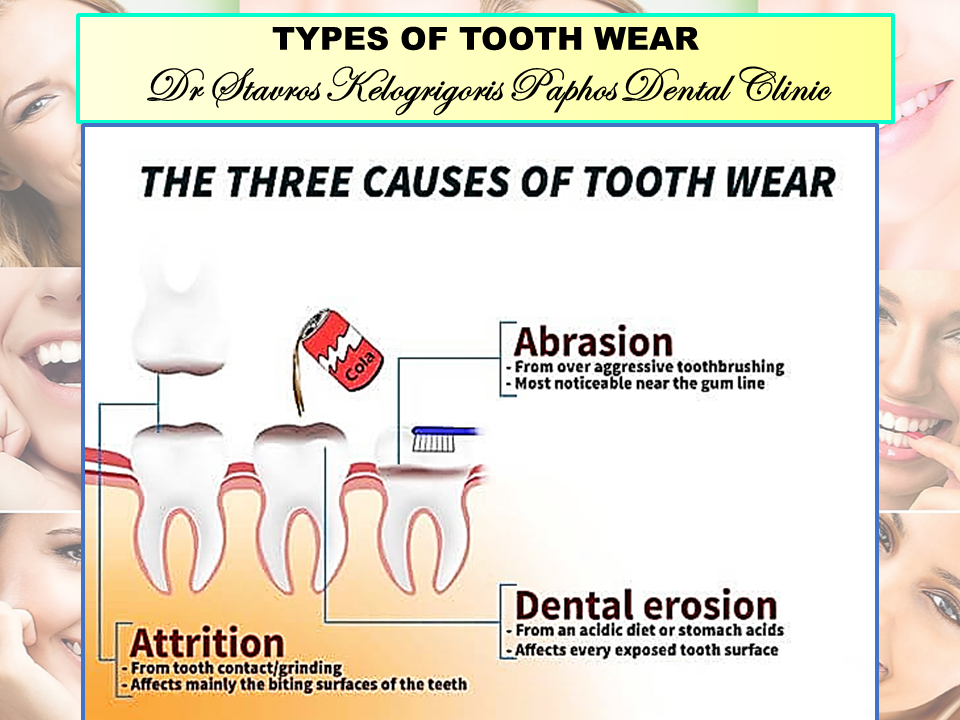Tooth Wear
What is Tooth Wear?
Tooth wear occurs when the outer tooth surface is lost as a result of chemical or mechanical activity in the mouth. An increasingly common problem, teeth can simply wear down or dissolve away to varying extents as time passes. This is in contrast to tooth decay and gum disease which are caused by the action of bacteria in the mouth.
Everyone experiences some tooth wear simply due to normal use of their teeth. It only becomes a real problem if the level of wear becomes rather more significant. As a result of one or more of the following causes, teeth can become short and unattractive as well as rough or sensitive. Even speaking or chewing can become a problem and some people also experience jaw and muscle ache.
How does tooth wear develop?
 |
There are four types of tooth wear commonly reported in the dental literature:
Abrasion - this form of tooth wear is caused by excessive rubbing away of enamel and dentine as a result of vigorous tooth brushing, porcelain crowns rubbing against natural teeth or a coarse diet as just some examples.
Attrition - contact between the teeth over and above normal use, as seen in patients who grind and clench their teeth at night, results in tooth wear which is often linked to a stressful lifestyle.
Erosion - tooth wear as a result of eating acidic foods and drinks (eg fruits and juices, alcohol, sparkling drinks, sports drinks) or having stomach acid regurgitation (eg hiatus hernia, bulimia, pregnancy sickness).
Abfraction - this occurs as a result of biting forces causing a tooth to flex and as a result, tiny fractures form in the enamel near the gum line.
These different types of tooth wear may occur separately or in combination.
What are the signs of tooth wear?
The most common signs and symptoms of tooth wear include:
 Increased levels of sensitivity, often dependant on the rate of tooth wear.
Increased levels of sensitivity, often dependant on the rate of tooth wear. Teeth may become less white as some of the outer enamel layer is lost.
Teeth may become less white as some of the outer enamel layer is lost. Front teeth may become sharp or chipped.
Front teeth may become sharp or chipped. Teeth may wear down resulting in an altered bite. Grooves may develop in the teeth near to where they meet the gums.
Teeth may wear down resulting in an altered bite. Grooves may develop in the teeth near to where they meet the gums.-
 Speaking and chewing can become a problem as the shape of the teeth change.
Speaking and chewing can become a problem as the shape of the teeth change.  Jaw and muscle discomfort may be experienced.
Jaw and muscle discomfort may be experienced.
What can I do to prevent tooth wear or limit its progression?
There are a number of simple steps that everyone can benefit from:
 Brush effectively yet gently with a relatively soft toothbrush.
Brush effectively yet gently with a relatively soft toothbrush. Use a toothpaste that is fluoridated to at least 1400ppm and low in abrasivity to limit further tooth surface loss and to help re-harden enamel more effectively after an acid attack.
Use a toothpaste that is fluoridated to at least 1400ppm and low in abrasivity to limit further tooth surface loss and to help re-harden enamel more effectively after an acid attack. After consuming acidic foods and drinks, wait an hour before tooth brushing to avoid damaging the already softened and more vulnerable enamel.
After consuming acidic foods and drinks, wait an hour before tooth brushing to avoid damaging the already softened and more vulnerable enamel. Try not to drink anything except still water between meal times.
Try not to drink anything except still water between meal times. Only consume acidic foods and drinks at meal times.
Only consume acidic foods and drinks at meal times. Limit fruit juice to once per day.
Limit fruit juice to once per day. Reduce or eliminate carbonated drinks.
Reduce or eliminate carbonated drinks. Do not hold or ‘swish’ drinks around the mouth and when possible drink through a straw to direct liquids towards the back of the mouth.
Do not hold or ‘swish’ drinks around the mouth and when possible drink through a straw to direct liquids towards the back of the mouth. If a mouthguard is worn whilst sports drinks are consumed, rinse the mouth and mouthguard with clean water during breaks or remove the mouthguard while drinking to minimise the effect of retained acid.
If a mouthguard is worn whilst sports drinks are consumed, rinse the mouth and mouthguard with clean water during breaks or remove the mouthguard while drinking to minimise the effect of retained acid. After meals, chew sugar free gum or rinse with alcohol free, fluoridated mouthwash to help neutralise acids and protect tooth enamel.
After meals, chew sugar free gum or rinse with alcohol free, fluoridated mouthwash to help neutralise acids and protect tooth enamel. If you clench or grind your teeth, actively trying to reduce stress levels may be benefit.
If you clench or grind your teeth, actively trying to reduce stress levels may be benefit.
What treatment is available?
It is important that you see your dentist for regular check-ups so that any tooth wear can be identified and monitored. Photographs and models can be very useful in comparing tooth wear from time to time.
The causes of tooth wear are often complex and, as such, your dentist may seek advice from medical and dental colleagues in related specialties. In this way, tooth wear can be better prevented and treated as part of an holistic approach.
In addition to the general recommendations listed above, your dentist may also advise on a mouthguard to protect against tooth grinding and even a particular toothpaste or desensitising agent.
In most cases, preventative measures suffice, but in certain situations it may be necessary to assist with the provision of more comprehensive treatment to restore both the appearance and function of the teeth, as well as protecting them from further wear.
.jpg)